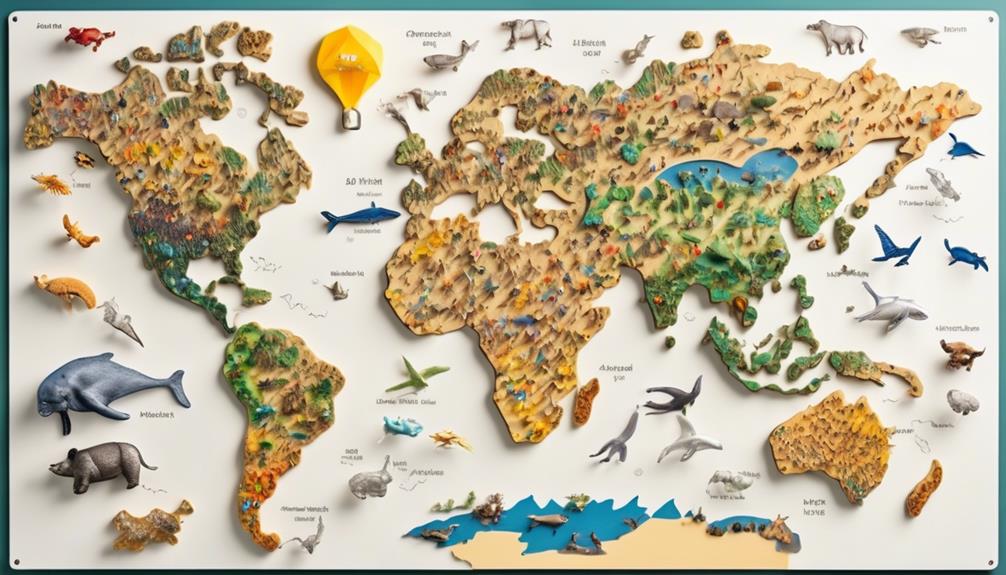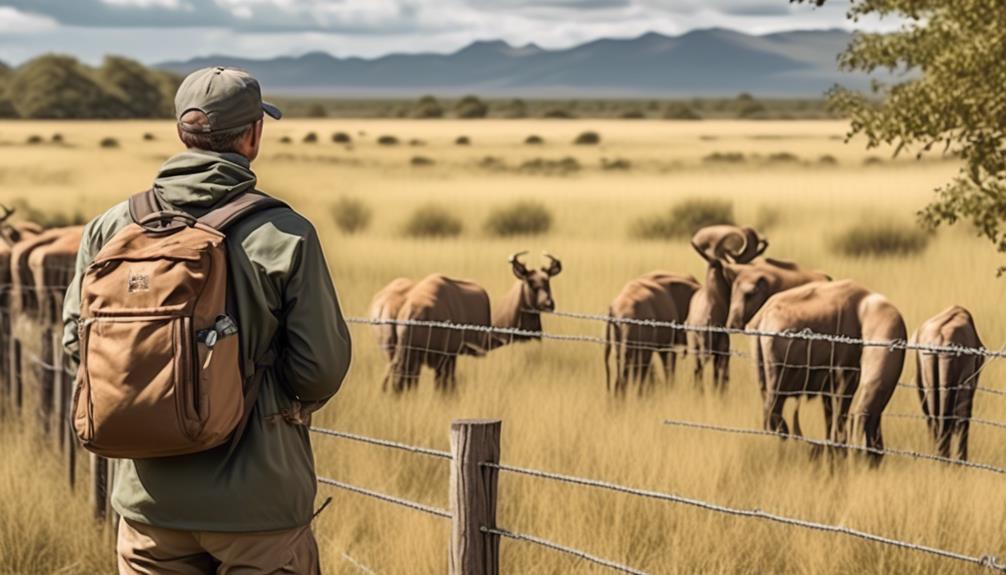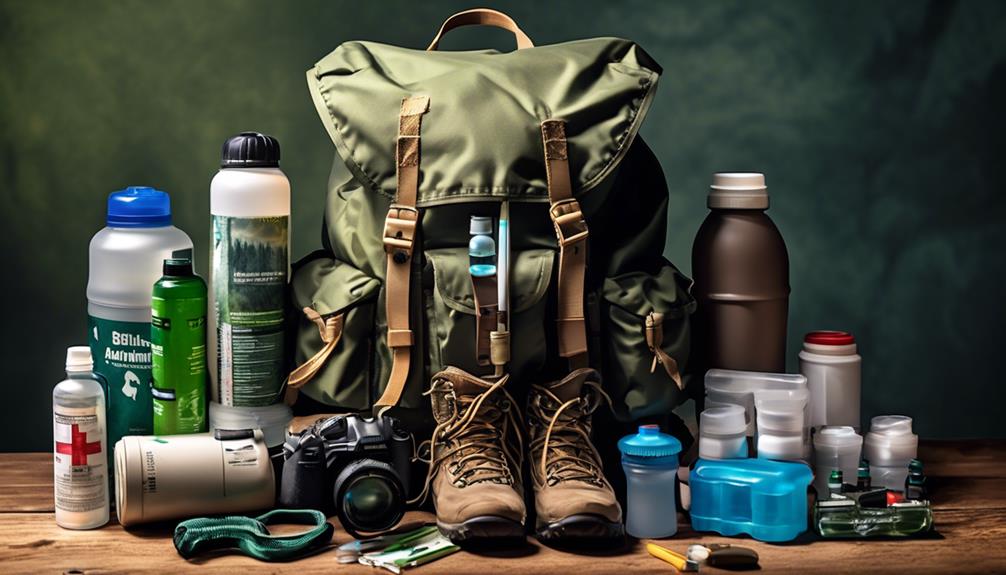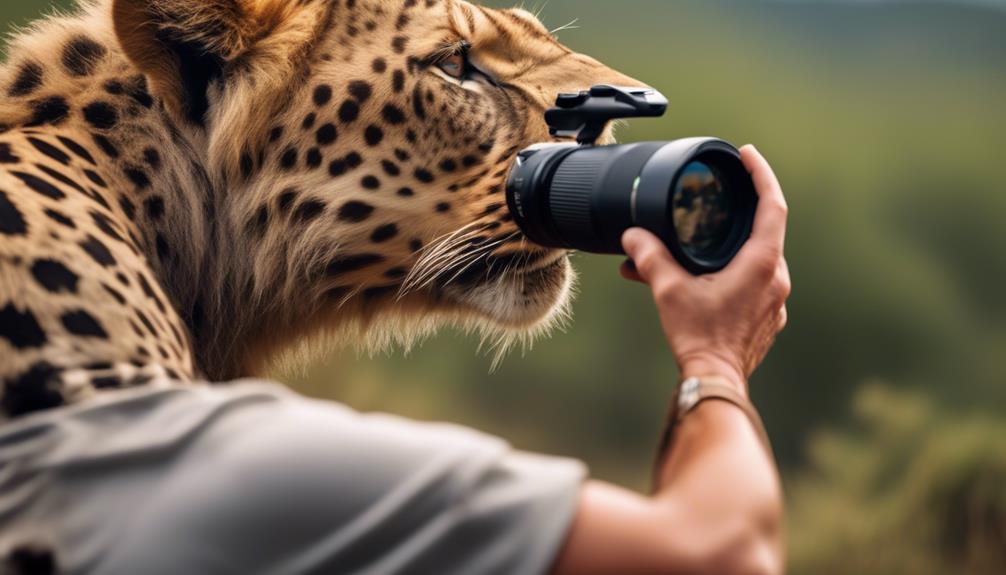Essential Tips for Adventure Wildlife Encounter Travel
When embarking on adventure wildlife encounter travel, it's crucial to equip yourself with essential tips that will ensure a safe and respectful experience.
From researching wildlife hotspots to understanding animal behavior, there are several key factors to consider before setting off on your journey.
These tips will not only enhance your encounter with wildlife but also contribute to the conservation and protection of these incredible creatures.
So, whether you're a seasoned wildlife traveler or a newcomer to the world of animal encounters, these essential tips will help you navigate the wild with confidence and responsibility.
Research Wildlife Hotspots

When planning your wildlife encounter adventure, start by researching wildlife hotspots to maximize your chances of seeing a diverse range of animals in their natural habitats. Wildlife hotspots are areas known for their high concentration of diverse species, making them prime locations for observing wildlife in action. When you choose to visit these hotspots, you aren't only fulfilling your desire for an up-close encounter with nature but also contributing to wildlife conservation efforts.
By visiting these areas, you're supporting the local economy, which in turn provides an incentive for the protection and preservation of the wildlife and their habitats.
Wildlife conservation is a crucial aspect of ecotourism, and by visiting wildlife hotspots, you're actively participating in this cause. Ecotourism benefits the environment and local communities by promoting sustainable travel practices and providing economic incentives for the protection of natural habitats. By choosing to visit wildlife hotspots, you're directly contributing to the conservation of these areas and the species that call them home.
In addition to supporting wildlife conservation, visiting wildlife hotspots also allows you to witness the benefits of ecotourism firsthand. You can observe how local communities have embraced sustainable practices and see the positive impact that responsible tourism has on both the environment and the people who live there.
Ultimately, by researching and visiting wildlife hotspots, you aren't only fulfilling your passion for wildlife encounters but also actively participating in wildlife conservation and supporting the principles of ecotourism.
Understand Animal Behavior
To fully appreciate your wildlife encounter adventure, understanding animal behavior is essential for safe and respectful interaction with the natural world. By familiarizing yourself with animal behavior, you can ensure a more enriching and secure experience. Here are some crucial points to consider:
- Animal communication: Animals communicate through various means such as vocalizations, body language, and scent marking. Understanding these modes of communication can help you interpret their intentions and moods, allowing you to gauge whether an animal feels threatened or at ease.
- Predatory instincts: Many animals have predatory instincts that govern their hunting and feeding behaviors. It's important to recognize signs of hunting behavior and maintain a safe distance to avoid triggering a predatory response.
- Territorial behavior: Animals often exhibit territorial behavior to defend their space and resources. Recognizing signs of territoriality can help you avoid encroaching on an animal's territory and provoking a defensive reaction.
- Social dynamics: Some species have complex social structures, and understanding these dynamics can help you anticipate their movements and behavior, ensuring that you don't disrupt important social interactions.
- Environmental cues: Animals respond to environmental cues such as weather changes, food availability, and seasonal patterns. Being attuned to these cues can enhance your chances of encountering wildlife in their natural habitats.
Respect Wildlife Boundaries

Recognizing and respecting wildlife boundaries is crucial for ensuring your safety and the well-being of the animals you encounter during your wildlife adventure. When engaging in wildlife observation, it's important to remember that you're a visitor in their natural habitat. Respecting their space not only minimizes the risk of potential harm to yourself but also ensures that the animals aren't unduly stressed or disrupted. Approaching too closely or attempting to touch or feed the wildlife can have detrimental effects on their behavior and well-being.
Understanding the environmental impact of your presence is also vital. Your actions, such as leaving behind litter or straying off designated paths, can have lasting consequences on the ecosystem and the animals that inhabit it. Always adhere to designated trails and guidelines set forth by conservation authorities to minimize your impact. By doing so, you contribute to the preservation of the environment for both the wildlife and future generations of adventurers.
Choose Ethical Tour Operators
Opt for ethical tour operators that prioritize wildlife conservation and sustainable practices to ensure a responsible and impactful wildlife adventure. When choosing a tour operator for your wildlife encounter travel, it's crucial to opt for those that are committed to ethical practices and the wellbeing of the animals you'll encounter.
Here are some key factors to consider when selecting an ethical tour operator:
- Commitment to Wildlife Conservation: Look for tour operators that actively support and contribute to wildlife conservation efforts. Choose operators who are involved in initiatives such as habitat preservation, wildlife rehabilitation, and community education on conservation.
- Responsible Viewing Practices: Ethical tour operators prioritize the welfare of the animals and ensure that viewing activities are conducted in a manner that minimizes disturbance to the wildlife. They adhere to guidelines that maintain a safe distance from the animals and limit the duration of the encounters to reduce stress on the wildlife.
- Support for Local Communities: Ethical tour operators work closely with local communities to ensure that the benefits of wildlife tourism are shared equitably. They contribute to community development projects and involve local residents in conservation efforts, creating a positive impact beyond the wildlife encounters.
- Transparent Policies: Choose tour operators that have clear and transparent policies regarding their wildlife interactions. They should be open about their practices, provide information on the welfare standards they adhere to, and have measures in place to ensure compliance.
- Certifications and Accreditations: Look for tour operators that hold recognized certifications or accreditations from wildlife conservation organizations or responsible tourism associations, demonstrating their commitment to ethical and sustainable practices.
Pack Essential Gear

When preparing for your wildlife encounter travel with ethical tour operators, it's essential to pack the gear that will ensure your comfort, safety, and enjoyment during the experience. Proper gear maintenance and packing organization are crucial for a successful wildlife adventure.
Start by organizing your essentials in a durable, waterproof backpack to protect your gear from the elements. Ensure that your clothing is layered, moisture-wicking, and suitable for varying weather conditions. Bring a reliable water bottle and purification system to stay hydrated during long excursions. Additionally, pack high-energy snacks to keep you fueled throughout the day.
For wildlife tracking and animal communication, consider bringing binoculars, a camera with a telephoto lens, and a field guide to identify species you encounter. A notebook and pen can be useful for jotting down observations and behaviors of the animals. To enhance your experience, pack a field whistle or a small harmonica that can be used for non-threatening communication with wildlife.
Proper gear maintenance is essential to ensure that your equipment functions optimally throughout the trip. Before departure, check that all zippers, straps, and fastenings on your backpack are in good condition. Inspect your footwear for durability and comfort, and break them in if necessary. Clean and test your camera and binoculars to avoid any technical issues during wildlife encounters.
Follow Local Guidelines
Following local guidelines is crucial for ensuring the safety of both wildlife and yourself during your adventure wildlife encounter. When you respect and adhere to the rules set by local authorities and experts, you contribute to the preservation of the natural habitat and the well-being of the wildlife that inhabit it.
Here are some important reasons why following local guidelines is essential:
- Wildlife Preservation: By following local guidelines, you play a vital role in preserving the natural habitat and the wildlife that call it home. Responsible behavior, such as maintaining a safe distance from animals and not feeding them, helps protect their natural behaviors and reduces the risk of negative human-wildlife interactions.
- Environmental Impact: Local guidelines are often designed to minimize the environmental impact of human activities. This can include rules about waste disposal, energy use, and minimizing disturbance to the ecosystem. By following these guidelines, you can help keep the environment pristine and minimize your footprint on the delicate ecosystem.
- Respect for Indigenous Communities: Many adventure wildlife encounters take place in areas inhabited by indigenous communities. Respecting and following their guidelines not only ensures your safety but also fosters positive relationships and supports local traditions and livelihoods.
- Safety: Local guidelines are often based on extensive knowledge of the area and the behavior of the wildlife. Following these guidelines reduces the risk of accidents and ensures a safe and enjoyable experience for everyone involved.
- Legal Compliance: Adhering to local guidelines ensures that you're in compliance with the law, avoiding potential fines or legal issues. It also sets a positive example for others and helps maintain the integrity of the natural environment for future generations.
Practice Responsible Photography

To capture memorable wildlife moments responsibly, practice respectful photography techniques that prioritize the well-being of the animals and their natural environment.
When photographing wildlife, it's crucial to set your camera to silent mode to minimize any disturbance to the animals. Additionally, avoid using flash as it can startle or distress the animals, especially in low-light conditions. Adjust your camera settings to ensure you can capture high-quality images without relying on artificial lighting that could disrupt the natural environment.
Consider the environmental impact of your photography. Stay on designated paths or areas approved for photography to avoid trampling on delicate habitats or disturbing wildlife. Be mindful of your surroundings and avoid getting too close to the animals, as this can cause stress and alter their natural behavior. Always prioritize the safety and comfort of the animals over getting the perfect shot.
When photographing wildlife in their natural habitat, be patient and allow the animals to go about their activities undisturbed. This approach not only ensures the well-being of the animals but also often leads to more authentic and captivating photographs. Remember, the goal is to capture the beauty of wildlife without causing any harm or disruption.
Stay Informed About Conservation
Staying informed about conservation efforts is crucial for enhancing your understanding of wildlife and their habitats. By staying updated on conservation initiatives, you can actively support wildlife preservation and environmental education.
Here are some essential tips for staying informed about conservation:
- Follow reputable conservation organizations on social media and subscribe to their newsletters to stay updated on their latest projects and initiatives.
- Engage in local community events and workshops focused on wildlife preservation and environmental education. These events can provide valuable insights and opportunities to connect with like-minded individuals.
- Educate yourself about the specific wildlife and habitats you're planning to encounter during your adventure travel. Understanding the challenges they face and the conservation efforts in place will enrich your overall experience.
- Support conservation efforts by donating to reputable organizations or volunteering your time to participate in conservation projects during your travels.
- Encourage others to join you in staying informed and supporting conservation efforts. By spreading awareness, you can contribute to a wider network of support for wildlife and their habitats.
Frequently Asked Questions
What Are Some Common Mistakes to Avoid When Encountering Wildlife in Their Natural Habitat?
When encountering wildlife in their natural habitat, common mistakes to avoid include approaching too closely, feeding them, and making sudden movements. Proper etiquette involves respecting their space and observing their behavior from a safe distance.
How Can Travelers Contribute to the Conservation Efforts of the Wildlife They Encounter During Their Adventures?
You can contribute to conservation efforts of wildlife during adventures by practicing responsible tourism. Respect boundaries, support sustainable interactions, and participate in local conservation projects. Your contributions help protect the wildlife and their natural habitats.
Are There Any Specific Tips for Interacting With Endangered Species While on a Wildlife Encounter Travel?
When encountering endangered species on your wildlife adventure, ensure responsible interaction by keeping a safe distance, following local guidelines, and respecting their natural behavior. Avoid disturbing their habitat and support conservation efforts whenever possible.
What Are Some Ethical Considerations to Keep in Mind When Choosing to Participate in Wildlife Encounters During Travel?
When choosing wildlife encounters, consider ethical considerations and responsible tourism. Support conservation efforts and endangered species protection. Respect natural habitats and avoid activities that harm or exploit animals. Prioritize the well-being of wildlife and the environment.
How Can Travelers Ensure That Their Wildlife Encounter Experiences Are Beneficial for the Animals and Their Natural Habitat?
To ensure your wildlife encounter experiences benefit animals and their habitat, practice responsible tourism. Respect boundaries, avoid disrupting natural behaviors, and follow wildlife photography etiquette. By doing so, you can contribute to conservation efforts and protect these precious ecosystems.
Conclusion
So, when you're planning your next wildlife encounter adventure, remember to do your research, respect the animals, and choose ethical tour operators.
Pack the essential gear, follow local guidelines, and practice responsible photography.
Stay informed about conservation efforts and always prioritize the well-being of the wildlife.
With these essential tips in mind, you can have a safe and unforgettable wildlife encounter experience.
